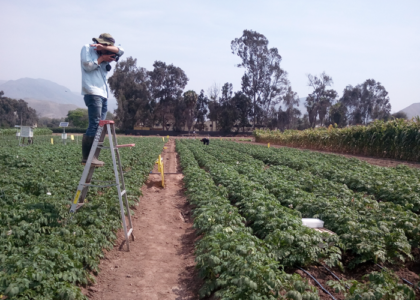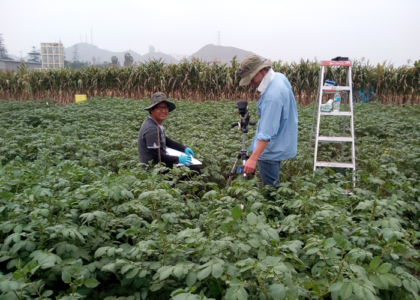
A new potato or sweetpotato variety represents only the “tip of the iceberg,” concealing hundreds, if not thousands, of hours invested in testing and developing that variety. As scientists at CIP work to produce better performing varieties to help the world’s smallholder farmers, we must first test these varieties under a wide range of conditions with regard to moisture, temperature and soil conditions.
Being able to evaluate the results of a test is an equally difficult challenge but CIP scientists are dedicated to developing stronger and more accurate testing methods to ensure that new varieties meet the needs of vulnerable communities in terms of yield, taste and nutrition.
To that end, a recent CIP study published in the journal Agronomy has provided strong evidence for the value of foliage or canopy temperature (CT) as key indicator for improving yield predictions for potatoes grown in water-restricted environments. Their findings indicate that CT can be reliably used to predict how potato varieties will perform in water-stressed environments – a condition that will become more common under future climate change scenarios.
“Most studies use soil water balance to predict yields in future scenario trials,” said Johan Ninanya, a research assistant in the crop and systems science division at CIP. “Our study compared the usefulness of CT for yield prediction against these classic models, and we found there is some advantage to using CT.”
Using CT to assess future yields of potato varieties will be an important tool for boosting farmers’ resilience against climate change. “Not only can we predict future potato yields better but using CT in prediction modeling gives us the power of anticipation to improve our resources management,” said David Ramírez, leader of CIP Crop Ecophysiology and Modeling lab in the crop and systems science division.

The promise of using CT in field trialing of new potato varieties extends beyond more reliable yield predictions. Ramírez says it will enable farmers to make more informed real-time decisions to improve their water use with irrigation. In agricultural areas prone to droughts, CT could be used to help farmers grow more potatoes by indicating more precisely when to plant potatoes and how much to water them.
“In other words, we can show smallholder farmers how to grow more potatoes and how to optimize their water use for a win-win situation,” Ramírez says.
While the findings were promising, the research team says future investigations will be needed to incorporate CT through infrared spectrum analysis using drones, satellite imagery and/or spatial modeling to achieve higher scales in potato yield prediction.
“The goal would be to build decision support tools at scale so that national agriculture extension services can advise more farmers where to irrigate more accurately,” Ramírez notes.
As climate change impacts intensify, having this support for vulnerable farmers will be a crucial tool to help these families and communities anticipate and weather future stresses on their potato harvests.
